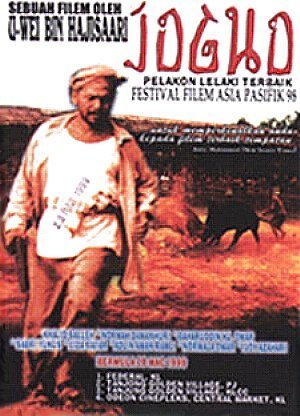Synopsis
Kaki Bakar(1995) is a movie that depicted a Javanese man who has married a Malaysian woman is facing the social inequalities. The story starts with an embittered wandering laborer named Kakang(Khalid Salleh) who act ridiculously by burning buildings. His son named Kasuma refused to testify it to against his father. Eventually, the village chief wants them to leave the village for good. Kakang with his family are now in the journey to find a place to settle down. Story climaxes they bump into Tuan Kassim, he gives Kakang the job as a rubber taper. Tuan Kassim’s assistant sends a carpet to Kakang to be washed by Kakang’s family. Unfortunately, the carpet has damaged. Therefore, Tuan Kassim requests Kakang to pay RM400 for the damaged carpet. Kakang knows that the incident is to exploit him, therefore has brought this matter to the juries. The juries think that he ought to pay the damaged carpet. With his raging Javenese spirit, he eventually burn the rubber storeroom meanwhile has shot dead by Tuan Kassim.
Jogho(1997) is a movie directed by U-Wei Haji Saari. It uses Kelantanese Malay dialect. Happened in South Thailand, the story begins where Lazim has killed by Isa at the bullfighting arena. This incident leaves Mamat to visit Kelantan and arrange for his friend Jaafar to find and kill the perpetrators. After some whiles, Lazim’s two sons and a friend went to the town and managed to kill Isa’s son, Hamdan and his assistant, Dollah Manduk. Three young men are eventually hiding somewhere however Mamat is arrested by the policemen. Mamat requests his wife to pay the bail so that he is able to fight the new bull.In the bullfighting arena, Isa comes to take revenge for the death of his son. The second shot is only managed to wound Mamat’s shoulder. Mamat grabs Isa’s gun but refuses to kill Isa but Lazim’s son, Sani however takes the gun and shoots Isa instead.However, Mamat surrenders to them and takes responsibility for the murder.
Reviews
Similarly, both movies have shown one of the most significant themes which are religion, family, culture and tradition.
Both movies show nice photography with its rich shadow at night and vibrant colors of rugs and fabrics as well as trees. The director tends to make the films move smoothly and it seems to be heading toward inexorable tragedy.
U-Wei Bin Haji Saari likes to use the value of family and the unconditional love. He always shows the audience that one will definitely stand to family side. For example in Kaki Bakar, Kasuma never mentioned anything about his father when being questioned by Tok Empat about the fire of the house so that his father may not accuse in the incident. Meanwhile in Jogho, it shows this value when Mamat gives his money to Lazim’s family to reduce the burden of Lazim’s family.
Theme that the director likes to use is the role and voice of male and female. Both movies show that male should always have to take care of their family and earn money for family. In Kaki Bakar, when Tok Empat asked Kakang to leave, Kakang shouted at his wife when she attempted to clean Kasuma's face. "He's not a girl coddle with", said Kakang. This follows by a tilt review his daughter in the back of the truck, along with the older son. Similarly in Jogho, bull fighting activity has portrayed as a masculine activity when women are not allow to step on the arena while the bull are fighting. Also, a clear example can be seen in Jogho in which during the funeral of Lazim, all women are stand far apart while the man is burying the dead body.
U-Wei Bin Haji Saari also likes to use slow dolly tracking shots to reveal the whole entire misc-en-scene. In Kaki Bakar, a scene obviously shows the value when Kakang instills some Javanese spirit to Kasuma while they are on the way to Tok Empat’s house. Whole scene is used dolly tracking to shoot. We indirectly have known that U-Wei uses the slow dolly tracking shot to express the reaction of each listener in the grocery store while ended with a guy who is speaking. The same techniques also apply in Jogho film. It is where a slow pan and tracking shot started from the scenery of Patani and ended with the funeral of Lazim. Moreover, the director uses diegetic sound with the camera movement to drag audience to the source of the sound.
U-Wei is transcending the script by imposing his film style and vision, blending subjective and personalized filmmaking practices across his films. So that, it will become a symbolic icon of all his film, audiences who watched the film will think of U-Wei, the director of the film.
Reference
James, C. (1996, April 6). Kaki bakar (1995) film festival review;faulkner, set in malaysia. The New York Times. Retrieved from http://movies.nytimes.com/movie/review?
Wong, K. (2006, June 15). [Web log message]. Retrieved from http://tyrannical-infant.blogspot.com/2006/06/silver-screen-kaki-bakar-arsonist.html
Asia pacific films. (2009). Retrieved from http://www.asiapacificfilms.com/films/show/334-the-arsonist
Annonymous. (2010, December 28). [Web log message]. Retrieved from http://www.teamaryzs.com/2010/12/jogho-1999-vcdrip-xvid-teamaryzs-multi.html

